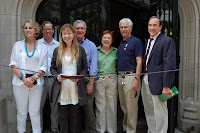
The Explorers Club is Monitoring Flags Like Never Before
©Copyright 2011 The Explorers Club
During the early part of the 20th century, Admiral Richard E. Byrd, an Honorary Member of The Explorers Club, carried three flags on his second Antarctic expedition in 1933-35. Yet by the mid-1950s, when their whereabouts were still a mystery, the celebrated explorer was reportedly miffed that Club officials would ask for them back. You can imagine the sense of unease when the Club president solicited board volunteers: “Who here wants to ask Admiral Byrd to return our flags?”
There are 202 numbered flags in existence, but several are still unaccounted for. Occasionally they turn up from time to time. In fact, just last spring, while rummaging through some old archives, polar explorer Paul Schurke of Ely, Minn., found number 124 that he had taken on his 1989 Bering Bridge Expedition. “It was mismarked in a box marked ‘Flags Flown at Pole,’” he reported somewhat sheepishly. It has since been returned.
Now flags are being tracked like never before thanks to a new website feature at Explorers.org. Log on, click Expeditions-Flag Expeditions–Interactive Map and view a real-time map of the flags almost anywhere in the world (the polar regions have yet to be added). Click an individual flag to read the Flag Report from that expedition, a report flag-carrying members are required to submit upon completion of their project.
The Explorers Club flag represents a history of courage and accomplishment and has been carried on hundreds of expeditions since 1918: to both poles, to the highest peaks of the greatest mountain ranges, to the depths of the ocean, and to outer space, perhaps someday even to Mars and beyond. Flag expeditions fulfill a fundamental part of the Club's mission: To engage in scientific exploration and share the results. Flags are constantly being re-circulated, even more so now. New durable nylon fabric construction withstands the rigors of expedition travel better than the cotton flags of old which often returned stained and in shreds.
Consider the tale of Flag no. 170. Starting in 1956 it went to the South Pole with Albert L. Raithel, Jr., then Nepal with John Alley (1968), the North Pole with Rev. Laurie Dexter (1981), Madagascar with Terry J. Cooper (1985), and the North Pole again with Will Steger’s first confirmed dog sled expedition (1986), with numerous stops in between.
“Flags are the ‘Good Housekeeping Seal of Approval’ for an expedition. We receive fantastic applications that are really impressive,” said former Club director and Flag and Honors Committee member David Concannon. Each year, the committee considers about 100 applications, rejecting at least half because they do not meet exacting standards of what constitutes a flag-worthy expedition. Just being first to do something is not enough; what matters is the science, the research, and how the project improves understanding of the world, according to Concannon.
Flags require a $250 deposit and, like Hollywood’s Oscars, can never be sold. Members don’t own the flag, they can only be borrowed. One year when a flag came up for auction at Christie’s, the Club had it removed despite strong interest from collectors to own one the easy way – with just a few strokes of a well-heeled checkbook.
Flags are only retired if they were taken on a trip where a member died, or if they participated in an historic expedition, such as the flags taken on three moon voyages and now displayed under glass in the Clark Room in the Club’s Lowell Thomas Building in New York. Nearby is flag number 2, featuring an older design, taken to the Gobi Desert in 1925 by famed paleontologist Roy Chapman Andrews. Also on display is Thor Heyerdahl’s retired flag no. 123 carried on the historic voyage of the Kon Tiki, an expedition that inspired many of today’s explorers. You can see it in one of the images in his famous book about the expedition.
Sadly, the last flag to be retired was no. 68 in 2009, carried by highly regarded British diver Carl Spencer, 37, who perished in 400 feet of water while diving the Britannic, sister ship to the Titanic. The flag began its career in 1937 and had twice voyaged aboard the Space Shuttle.
“Members have studied some of the world’s greatest mysteries,” said Club President Lorie Karnath. “The Titanic, the tombs of pharoahs, Amelia Earhart’s disappearance. I’m sure we’re up to the task of locating more of the missing flags, especially with the help of the new mapping feature on Explorers.org.” She tells Club members, or anyone else for that matter, “If you have a flag, or know the whereabouts of one, let us in on the mystery and we’ll track it down.”






